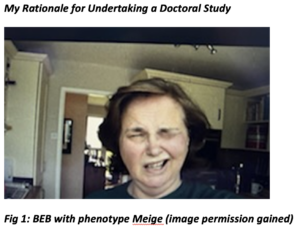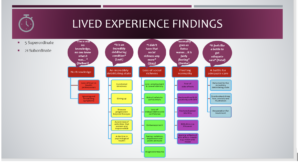By Dr. Nicola Dunlop RGN PhD @NicolaDunlop13
Prior to Covid 19 researchers were not usually considered change leaders but that is exactly what I achieved with this study. As an expert practitioner in the fields of Benign Essential Blepharospasm (BEB) I felt compelled to respond to investigate and reorganise care and treatment. The condition BEB causes bilateral eyelid muscular contractions, intermittent blinking and or sustained closure of the eye that can be disabling (DeFazio, 2017) in the mainly older population that I see. It is progressive and subtypes can develop in the lower face and neck . The treatment Botulinum toxin plays a major role in addressing quality of life (Hellman and Torres-Russotto 2015). However, it only offers temporary relief and the reason for effectiveness and duration which varies is unknown (Jinnah et al., 2013). However, a shorter treatment cycle of 6 weeks was deemed clinically safe (Jankovic et al., 2011). Patients’ feedback suggested, the care provided often fail to meet individual needs when required. The latter was enough motivation for me to make a difference. Therefore I explored the impact of untimely care and treatment lives of people with BEB experiences. As a novice researcher the experience provided tremendous learning.
An Antiquated Views of a Doctoral Studies
In my very lacking opinion all that was required was university acceptance, sponsorship or payment for same, investigating and writing the study. I was wrong. Being the first nurse to apply for funding for doctoral research at Moorfields Eye Hospital my knowledge of funding a research portfolio at the Trust was frankly quite limited. It was effortless to acquire course payment but funding for the actual research portfolio was a challenge.
The Funding Challenge
Although university and Trust ethics was approved granted without a funded portfolio, I was unable to commence my study. Moorfields Eye Charity, had no PhD grants for nurses or optometrists. I met with the charity and raised the concern. Though the need was highlighted current protocol would not permit the funding of my study but change was promised. The pledge made did not address my current funding plight or the stagnation of my study.
Managing Difficulties and Creating Change
Scouring the internet, I quickly recognised there was a lack of funding for nursing research and the funding streams available through the Royal College of Nursing was closed. Fight for Sight Grant would become available in 6 months’ time. It was extremely competitive which meant there was no guarantee. In addition, I did not have time to wait. At approximately 11:37hrs 31st January 2018 I found The Burdett Nursing Trust call, a short tack application which offered £7700. I was euphoric and immediately applied. I was successful and was able to fund my research. To set up a research portfolio administration alone cost £2000, a new study computer £1700 the cost of a Dictaphone £50 participants, printing £419 along with participants expense £64. This leaves a total of £2767 towards conference, travel, publishing and disseminate the study.
Indirectly my research informed the creation of the Moorfields Eye Charity funding call for PhD students. Importantly, The Burdett Nursing Trust, is the first external research fund for a nurse at Moorfields Eye Hospital has been truly an enabler of my study and the outcome it has achieved.
How was the Research Conducted?
The study took an interpretivist phenomenological approach with interviews and a focus group examining the thoughts, feelings and emotions of ten BEB participants. Reflective questions on: the diagnostic journey, treatment and care in both primary and tertiary care, what it means to live with BEB and what needs to change to improve the service was asked.
What were the Findings? Five superordinate themes emerged from the data following in-depth analysis of transcribed interviews and field notes: (1) No knowledge; (2) An incredibly debilitating state; (3) Fleeting normality; (4) Loss of social richness; and (5) A battle for adequate care.
One Step Further – This Research Created Change. Introduction of holistic, individualised treatment appointment through patient-initiated follow-up appointments, patient assessment via video clinics to facilitate more supportive, effective, and successful management. More nurse-led clinics to reduce geographical disparity. Widespread training of all injectors to provide uniform care and treatment. It has also informed electronic documentation of patient records. Further change expected is the address of delayed referral by communicating a list of BEB red flags to Primary Care and an established focus regular rather than ad hoc focus group.
How Collaborative Working Can Continue to Create Change? Due to the scarcity of information about the condition BEB, this study has called for improved knowledge among health professionals with caregiving roles and throughout society. However, patients also must take responsibility and adopt pro-active approach to reduce diagnostic delays and expedite care to prevent visual, physical, and psychological decline. There is a call for more collaborative partnership with patients in primary care and secondary care and the redesign of service which has now become a reality not only at Moorfields Eye Hospital but throughout the United Kingdom.
References:
Defazio, G., Hallett, M., Jinnah, H. A., Conte, A., & Berardelli, A. (2017). Blepharospasm 40 years later. Movement Disorders: Official Journal of the Movement Disorder Society, 32(4), 498-509. https://doi.org/10.1002/mds.26934
Hellman, A., & Torres-Russotto, D. (2015). BTX in the management of blepharospasm: current evidence and recent developments. Therapeutic advances in neurological disorders, 8(2), 82-91. https://doi.org/10.1177/1756285614557475
Jankovic, J., Comella, C., Hanschmann, A., & Grafe, S. (2011). Efficacy and safety of incobotulinumtoxinA (NT 201, Xeomin) in the treatment of blepharospasm: A randomized trial. Movement Disorders: Official Journal of the Movement Disorder Society, 26(8), 1521-1528. https://doi.org/10.1002/mds.23658
Jinnah, H. A., Berardelli, A., Comella, C., Defazio, G., Delong, M. R., Factor, S., Galpern, W. R., Hallett, M., Ludlow, C. L., Perlmutter, J. S., Rosen, A. R., & Dystonia Coalition Investigators (2013). The focal dystonias: Current views and challenges for future research. Movement Disorders: Official Journal of the Movement Disorder Society, 28(7), 926-943. https://doi.org/10.1002/mds.25567


